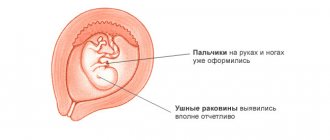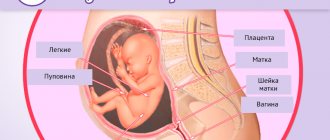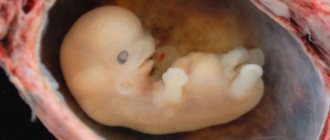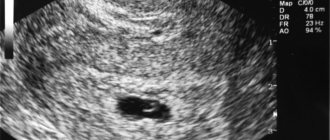Changes that happen to the expectant mother
By this time, a pregnant woman is already getting used to the changes that constantly occur in her body. This period falls on maternity leave, when there is no need to rush to work and you can devote all your free time to yourself and preparing for the upcoming birth. It seems like there is still a long way to go, but that may not be the case.
Readiness for childbirth is determined not only by how the woman feels, but also by whether the fetus meets normal weight standards at 33 weeks of pregnancy. Most likely, by this time she will have already undergone the third screening, which includes the mandatory procedure of undergoing an ultrasound examination. The specialist determines height (it should be between 35-45 cm) and weight (approximately 1700-2000 g) using a table of norms. It is necessary to take into account the personal parameters of the parents; if both of them are not tall or large in body weight, then most likely their baby will also have miniature parameters. Therefore, the issue of compliance or deviation from these standards should be approached on a purely individual basis. Do not forget that even if there is a lag in the weight of the fetus at the 33rd week of pregnancy, then, most likely, closer to the birthday it will gain the necessary grams. The main thing is that the expectant mother remains calm and follows a daily routine and adheres to proper nutrition.
Based on the obtained indicators, you can only get an idea of the approximate weight of the child. Determining these parameters is necessary in order to have an idea at the time of birth regarding the likelihood of the birth of a large fetus, its location, the state of the amniotic fluid and the placenta. This may affect the method of delivery.
As a rule, if a child at 33 weeks of pregnancy weighs less than the established norm, then this is not a reason to panic. In practice, doctors prescribe vitamin therapy, and recommend that the mother take more walks and rest.
Feelings of the expectant mother
During this period, due to the active weight gain and growth of the fetus, a whole range of sensations may occur. The baby grows very quickly and is cramped in the mother’s belly. The main sensations now will be the movement of the fetus, which has now become less active and frequent, but at the same time every movement is felt very clearly. Some of the pushing and kicking can be painful for the mother, especially if the fetus hits the ribs, liver or bladder. Monitor the number of fetal movements; they should occur at least five to six times per hour.
Nowadays, a woman’s mood is changeable due to changing hormonal levels, a changing body and fear of the upcoming birth. You need to devote more time to yourself and rest, sleep during the day and walk a lot. You also need to do exercises to unload the back and abdomen, taking the knee-elbow position several times a day for 10-15 minutes.
- What can a nursing mother eat after giving birth?
- Beef basturma at home - recipes with photos. How to make dry-dried beef in Armenian style
- Open a current account for an individual entrepreneur: which bank is better?
External changes in a pregnant woman
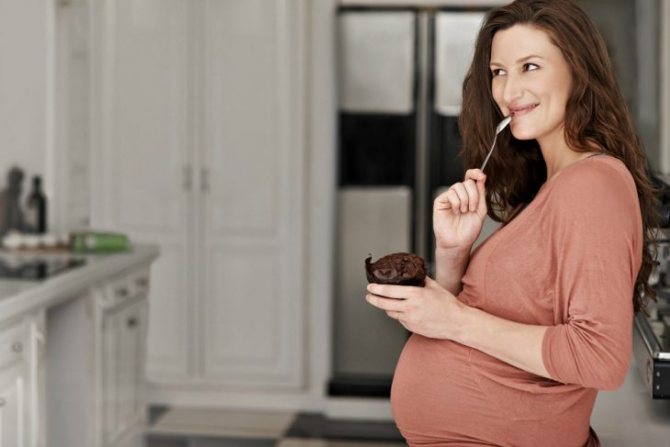
Without an ultrasound, it is impossible to imagine how a child develops inside the mother's womb. Only with the help of this research method can you see with your own eyes what the baby is doing at the moment, how he feels, whether or not there are deviations in the development of internal organs and body parts. But there is one drawback: you cannot resort to this method of observation all the time. Consequently, how pregnancy is progressing can only be judged by how the belly grows at 33 weeks of pregnancy and how much weight the woman has gained. The processes occurring inside the mother’s body are also judged by the results of blood and urine tests, the presence of edema and any complaints about well-being.
At this stage of pregnancy, the expectant mother may notice that the growth of the abdomen has slowed down somewhat. This is due to the fact that the peak of its intensive growth occurs in the second trimester, when changes in its shape and size become noticeable every week. At 32-33 weeks of pregnancy, the belly becomes more rounded, in some pregnant women it becomes more convex, as if there is a ball inside. The external outlines acquire smooth contours, and the position of the baby determines what the upcoming birth will be like. This means that if the baby is positioned head down, the birth will most likely take place naturally, since in the pelvic position (when the baby is head up) a cesarean section is recommended. But even if at this time the child has not yet accepted the correct position, this does not mean at all that he will not change it during the birth process. And this happens in practice, so there is no need to worry in advance.
In addition to the increase in the size of the abdomen, changes also occur in the appearance of a pregnant woman. People around you may notice that not only your tummy is rounded, but also that your facial features become softer in appearance. This is due to the active work of hormones that the mother’s body actively produces. Most women note that their hair has become stronger and their nails break less.
The gait also changes, the movements are no longer so fast. In some cases, women note that the sciatic nerve may become pinched, and then the gait becomes like a duck's. But don’t be shy about it; you can reduce the load if you go slowly. A growing belly makes itself felt more and more; leaning forward or simply sitting down becomes more and more difficult. Therefore, it is extremely important that someone close to you is with the pregnant woman and helps, for example, put on shoes or place a pillow under her back while resting.
Stomach ache
During a normal pregnancy, there should be no abdominal pain. The uterus is relaxed, the ligaments are stretched and only light training contractions can occur, which will not bring any pain or discomfort. If you experience abdominal pain or severe discomfort, you should talk to your doctor and undergo further examination.
If pain occurs in the lower abdomen with a sharp thickening of the uterine wall, if there is severe pain in the lower back, especially with bloody discharge, placental abruption can occur, a condition dangerous for the mother and fetus. Immediate hospitalization to a maternity hospital and life-saving measures are required. With a small area of detachment, it is possible to use conservative methods of therapy to prolong pregnancy.
Pain can also be in the back, lower back, sides of the abdomen or in the pelvic area due to the growth of the fetus and the pressure of its weight. This occurs due to a change in the center of gravity, stretching and softening of the ligaments. Wearing a bandage, special exercises and frequent rest can relieve these pains.
How does a pregnant woman feel at this stage?

Visits to the doctor and monitoring of the gestational age occur according to the weeks of the fetus’s gestation. Therefore, it happens that the question of how many months are in the 33rd week of pregnancy may confuse some. In fact, everything is not so difficult, the given period is 8 months and 1 week. Any deviations from normal well-being should alert the expectant mother. The appearance of late signs of toxicosis may lead to the need to go to the hospital for a while. The reason for this measure may also be a deviation from the normal weight of the fetus at the 33rd week of pregnancy. In order to maintain the general well-being of the mother and stimulate the baby’s weight gain, a vitamin complex is prescribed in the form of intravenous injections, as well as drugs to normalize blood supply (for example, Curantil).
The norm is considered to be training contractions, which can begin from the 33rd week. In order to reduce tone and muscle spasms, it is recommended to use “No-Spa”, “Papaverine”. You can take a warm bath; directing the shower stream to the lumbar area helps. If after all the manipulations the cramping attacks have not stopped, it is recommended to consult a doctor.
At this stage, anemia may occur due to low hemoglobin, so it is worth including foods rich in iron in your diet. If the duration of sleep is less than eight hours a day, then circles under the eyes cannot be avoided. To prevent this, it is recommended to interrupt your activity even in the afternoon. The optimal sleeping position on the side is becoming familiar to most pregnant women. This is an important point, since the enlarged uterus when lying on your back can lead to compression of the vena cava. The woman may feel that the baby is beginning to move actively, which in this case is a sign of insufficient oxygen supply.
It is worth paying attention to the discharge; if there are streaks of blood in it, a lot of mucus, then, most likely, the mucus plug begins to come off. This symptom is not typical for this time, so it is recommended to consult a doctor.
Causes of pain
Pain can occur at any stage of pregnancy, but it is important to correctly determine its source:
- Pain during urination may indicate a genitourinary infection. Body temperature may also increase, and sometimes unusual discharge from the genital tract may appear.
- Hemorrhoids are indicated by pain in the rectal area and the appearance of blood stains on underwear.
- Headaches indicate a lack of rest, excessive fatigue, overheating of the body or oxygen starvation. Often, to get rid of it, you just need to lie down to rest or take a walk in the fresh air.
- Due to increased weight, pain may appear in the back, legs, and lumbar region. To reduce them, you need to carefully monitor your posture, wear a prenatal bandage, and choose comfortable shoes. It is necessary to avoid prolonged physical activity, do not lie on your back, do not sit on chairs without a back.
- Lumbar pain bothers almost all pregnant women. They are associated with pressure from the enlarged uterus on the sciatic nerve. The pain intensifies if the woman lies on her back.
- Pain in the knee joints occurs due to increased load on them. Cool baths help reduce pain in the lower extremities. After this procedure, it is good to raise your legs to some height.
- Pain in the pelvic area and pubic area appears due to the fact that the woman’s body is gradually preparing for the process of childbirth. The pelvic bones slowly move apart, which causes discomfort. Swimming, wearing a bandage, and taking a bath help reduce their severity.
- Pain in the hypochondrium occurs due to the fact that the child has grown up and began to kick the mother from the inside with greater force. Noticeable fetal movements are often associated with an uncomfortable position that the woman takes, or with external pressure on the uterus. As the belly lowers before giving birth, the pain in this area will become less intense.
In any case, you should report any pain to your doctor. Sometimes at 33 weeks of pregnancy, training contractions occur, so a woman may feel a slight painful tension in the lower abdomen. This is normal, provided that the intensity of contractions does not intensify. Otherwise, you need to call an ambulance.
How is the baby feeling?
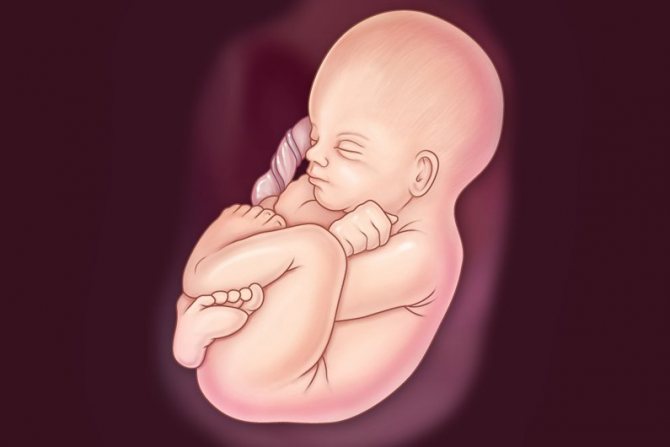
There is less and less free space left inside the placenta for the baby to actively move. The mother may note that fetal movements at 33 weeks of pregnancy become more coordinated. At this stage, the child’s internal organs continue to form. In particular, subcutaneous fatty tissue is formed, an iron reserve is formed in the liver, the endocrine system completes stages of development, the walls of blood vessels thicken, and the heart increases in size. The child is actively interested in what is happening outside. It can react to loud sound, bright light.
One of the important indicators of health is the formation of one’s own immunity. While the baby is in the womb, he is protected by the mother's body, but as soon as he is born, he will need his own protective resource that will protect him from harmful microorganisms.
If at the 33rd week of pregnancy the normal weight of the fetus is determined by ultrasound, then this study determines the degree of maturity of the lungs. This indicator is important because in the event of emergency development of labor it determines the survival of the fetus. It is worth noting that, along with data on lung development, liver echogenicity indicators are compared. Normally, they should coincide and be equally developed.
Alarming symptoms
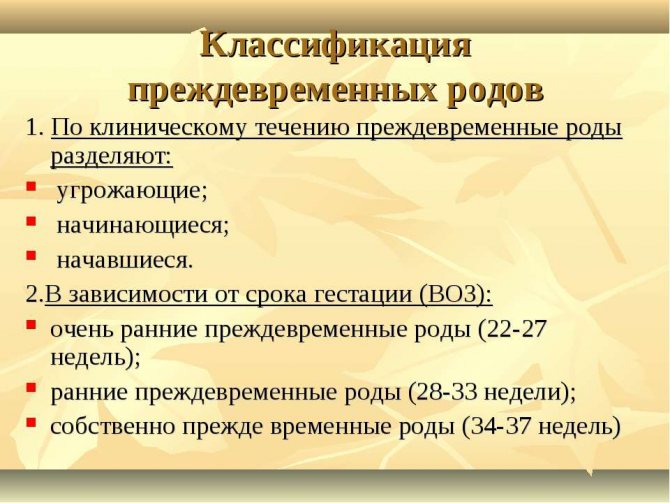
If there is constantly increasing pain in the lower abdomen, radiating to the lower back, you need to call an ambulance. Spasms may indicate the onset of labor: contractions are repeated, each new one becoming stronger than the previous one. There is rupture or leakage of amniotic fluid. Possible bleeding.
It is possible to understand what is happening only after examination in a gynecological chair. If contractions fail to provoke the opening of the uterine os, doctors will make every effort to maintain the pregnancy; if labor has begun, they will help the baby to be born. At this stage after birth, 90% of children remain viable. The staff manages to get them out, but the mortality risks are high, since babies are born with an imperfect thermoregulation system and low body weight. For many, the lungs do not open, so there is a need to use an artificial respiration apparatus.
Immediately after birth, premature babies are placed in an incubator, provided with artificial nutrition, and given drug treatment. Childbirth at 33 weeks is more dangerous for the mother herself: the cervical canal is unable to open completely, because of this there is a possibility of ruptures and uterine bleeding. You can minimize risks if you have experienced obstetricians and gynecologists nearby.
Nagging pain in the lower abdomen, a toned uterus, scarlet-colored bleeding, rapid heartbeat, a sharp drop in blood pressure, weakness, tinnitus, pale skin are symptoms indicating placental abruption.
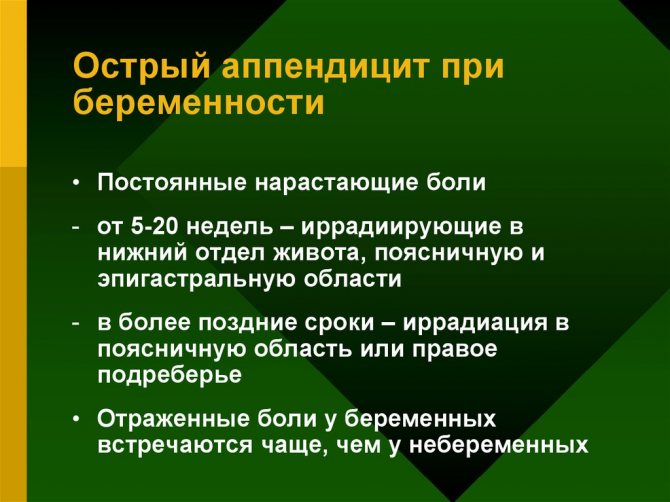
Pregnancy is a predisposing factor in the development of appendicitis. The uterus at 33 weeks is capable of compressing the vermiform appendix of the cecum. Poor blood circulation in it causes an inflammatory reaction. Its development occurs in stages. At first it covers only the mucous membrane of the appendix, after 6-12 hours it spreads to the submucosal layer and partially affects the muscular layer. After another 12 hours, the stage of gangrene begins - the walls of the appendix die, the contents of the intestines spill into the abdominal cavity, and peritonitis develops.
The pathology can be recognized by its characteristic symptoms: pain develops on the right side, is constantly present, intensifies when lying on the side, coughing and sneezing. It radiates not into the back, but up into the hypochondrium. Due to the large belly, signs of peritoneal irritation cannot be detected. It is also difficult to navigate by other characteristic symptoms: nausea, vomiting, increased body temperature. They may be unexpressed or appear later than usual. Often the moment when a woman can be helped is missed, so the mortality rate among pregnant women with appendicitis is very high.
Determination of fetal development parameters by ultrasound
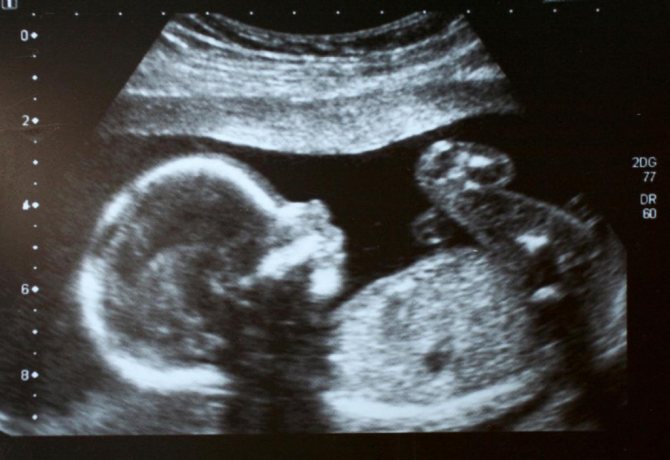
An ultrasound examination is necessary not only to determine height and weight, but also to understand what is happening to the baby at 33 weeks of pregnancy. All sizes from head to legs are determined visually on the screen. These parameters make it possible to determine the correspondence of fetal development to the established gestational age. In particular, the following values are measured (the norms will be indicated in brackets):
- Circumference of the head (289-333 mm) and abdomen (267-325 mm).
- Biparietal size (77-91 mm).
- Fronto-occipital size (98-116 mm).
- Nasal bone (8.9-13.9 mm).
- Coccyx-parietal size (at 33 weeks of pregnancy, the size of the fetus is about 30 cm).
- The length of the bones to be measured is: humerus (53-63 mm), forearm (46-54 mm), thigh (58-68 mm), lower leg (54-62 mm).
It is worth considering that during multiple pregnancies, the size and weight of the babies may differ from the given norms. Therefore, you should not expect that at 32-33 weeks of pregnancy they will fit the generally accepted standards. As a rule, by the time of birth, the weight of one baby can be no more than 2500 g, and the second is only 200-300 g heavier than the first.
The normal weight of the fetus at the 33rd week of pregnancy also depends on the lifestyle of the expectant mother, heredity and the presence of pathologies. If polyhydramnios is established, the child may weigh less than expected. This also confirms the likelihood of developing a congenital disease. It is for this reason that it is important to monitor the well-being and changes that occur in the child’s body throughout the entire period of pregnancy.
Ultrasound and other tests
At 33 weeks of pregnancy, an ultrasound examination is necessary to assess the development of the fetus. The doctor will record the exact dimensions and weight, and note all the existing anatomical features of development. Ultrasound helps to exclude the presence of pathology and developmental anomalies, fetal presentation and entanglement of the umbilical cord
As a rule, the gender of the unborn child has already been determined. If this did not happen before, then certain difficulties may arise now. After all, there is less and less space in the stomach, which means that the child can squeeze his legs and close his genitals.
During an ultrasound, the doctor also evaluates the condition of the placenta, the quantity and quality of amniotic fluid, uteroplacental blood flow, and the degree of maturity of the cervix.
Sometimes the doctor adjusts the already set date of expected birth. If a woman receives any therapy, then after the study it may be changed, because more and more information about the condition of the fetus is becoming available.
Thus, an ultrasound at 33 weeks of pregnancy is an important and extremely informative study that must be done without fail. This diagnostic method often helps doctors make very important decisions, for example, about the need for early delivery. In the vast majority of cases, an ultrasound simply allows you to once again make sure that the pregnancy is proceeding normally and everything is fine with the baby.
Other tests and examinations
At this time, the woman should also visit her gynecologist, donate blood and urine for a general analysis. At the appointment, the doctor will measure the height of the uterine fundus, abdominal volume, blood pressure level, and listen to the fetal heartbeat. The normal height of the uterine fundus is 33 cm (deviations of 1-2 cm are allowed).
In addition, this week the woman gains about 300-550 g in weight. The volume of circulating blood in the body increases. There is already a liter more of it than before the moment of conception.
If there are any deviations during pregnancy, then it is possible to determine the level of hCG (the norm is 2700-78100 mIU/ml), dopplerography, CTG and other studies.
Movements and their intensity

The force of the blows becomes more noticeable than before. This is due to the fact that the child is gaining muscle mass. The volume of amniotic fluid decreases slightly. The fetus spends more and more time sleeping, and the woman can clearly distinguish its activity mode and rest periods. At 33 weeks of pregnancy, the baby can see his first dreams. This is caused by the fact that connections between neurons begin to appear in the fetal brain.
Doctors recommend monitoring the intensity of movements; the norm should be at least 10 times in two hours. It is necessary to take into account even the slightest movements of the baby. Excessively frequent and active movements may also indicate a lack of oxygen. Therefore, it is worth regularly ventilating the room in which the pregnant woman is located, and being in the fresh air for at least 3-4 hours a day.
Fetus at 33 weeks of gestation: movements, development, weight and size
The size of your belly is rapidly increasing. Now he weighs about 2 kilograms and has stretched up to 44 cm. There is less and less space in the tummy, and, starting from the 33rd week of pregnancy, it is almost impossible to roll over there. But the baby is so strong that mom feels the kicks in the ribs too well. Be patient, it will start to go down soon.
In the meantime, you can especially “vividly” from time to time feel how the baby knows how to “walk” along the ribs, periodically resting his legs on them or pounding the ribs from the inside. To relieve pain, try to find a comfortable position - perhaps the baby is simply uncomfortable. You can also resort to performing the “evil and good cat” exercise: when the back first arches and then bends. By the way, this exercise is very useful for the spine, and therefore is also included in the set of exercises for pregnant women.
Meanwhile, the maturation process continues. The work of the main systems of the body - the central nervous, endocrine, immune - is already well established. The alveoli are mature, the heart and blood vessels are growing and strengthening, as well as muscle mass, and the brain is developing.
The baby’s appearance is as close to perfect as possible - the proportions of body parts are equalized, and lanugo begins to disappear.
The baby has a well-developed sense of smell. Try not to use strong-smelling substances, eat and drink only healthy foods, and surround yourself with the cleanest air possible.
As for the intensity of the baby’s movements, keep in mind: it is different for each child, because each one also has his own disposition and temperament. In general, the number of movements should remain at the level of last month. Doctors call the generally accepted norm at least 10 movements within 2 hours. At the same time, every tangible movement of the baby is taken into account - pushes, kicks, blows, movements of the whole body. If after 2 hours you do not feel these same 10 movements, you feel a significantly smaller number of them, it is better to go for a consultation with a doctor.
Future mom
Monitor your health and weight gain. You need to try to prevent the development of gestosis, because in this case it becomes bad for both: both the mother and the fetus. Do not rush to deal with high blood pressure on your own. If you observe this sign in yourself, tell your doctor, since increased blood pressure during gestosis is a protective mechanism: this condition of yours becomes life-saving for the fetus.
Strange tremors, or How to understand that a child is hiccupping
Similar to movements, but more regular and longer in duration - this is all about the first signs of hiccups in a child. It cannot be confused with the normal movements of a child. If it is located correctly in the womb, we are talking about the cephalic presentation of the fetus during pregnancy at 33 weeks, then rhythmic tremors will be felt in the lower abdomen. The movement of the legs will be felt in the ribs, in the upper abdomen. With the pelvic position of the fetus, everything will be exactly the opposite. Accordingly, with a transverse position, the head will be on the side, from where the mother will feel the corresponding shocks.
There is no clear criterion regarding the frequency of cases of hiccups in a child during the day. Some pregnant women noted this phenomenon throughout the day: morning, afternoon and evening. Others, on the contrary, once every few days. There are several versions about why this happens, for example, some believe that in this way the baby’s body prepares for birth by training the lungs. According to another version, he swallows amniotic fluid, which causes contractions of the diaphragm. Therefore, if at 33 weeks of pregnancy a child hiccups, then this is more the norm than a deviation.
In any case, do not immediately panic. A sign of hypoxia (lack of oxygen) is a decrease in hemoglobin and lack of fetal movement. In other cases, it is necessary to adhere to the correct sleep and rest regime.
Why does your stomach hurt?
With a successful pregnancy, a woman does not experience pain in the abdominal area at this stage. Therefore, if you experience abdominal pain, tell your doctor in detail about the nature of these sensations.
Stretching and painless training contractions are already familiar to you. From the 33rd week of pregnancy, a woman may experience somewhat painful uterine contractions, confirming the high tone of the uterus.
Don't worry if you experience mild, nagging pain in the lower abdomen. The cause for concern in this case is the increase and frequency of such contractions, accompanied by very severe pain. These symptoms may indicate that you may be going into premature labor at 33 weeks of pregnancy.
Abdominal tenderness may be a sign of placental abruption. Often with placental abruption, bleeding is observed, and internal bleeding may also be present. Pathology of the placenta may be indicated by pain in the lumbar region and painful sensations in the uterus. This picture requires immediate medical attention.
Fetal position norms

The main questions that concern not only parents, but also the doctor: what happens to the baby at 33 weeks of pregnancy, how does he feel, what position is he in the uterine cavity? It is believed that with a premature birth at this stage, the baby is born quite viable. One of the important parameters that are determined at this stage of pregnancy is the position of the fetus in the womb. The most unfavorable option is a transverse arrangement. It is an absolute indication for delivery by cesarean section. The least successful option, but likely for natural delivery, is the pelvic position of the fetus. However, this also has its own characteristics, which are determined closer to the expected date of birth.
It is believed that the main part of the difficult journey has been completed, the calendar shows the 33rd week of pregnancy, how many months are already behind us, we can safely say that this is the home stretch. Therefore, it is necessary to accept the fact of the location of the fetus and not worry if obstetric care is carried out through surgery.
Different fetal positions may occur in multiple pregnancies. In this case, it is almost likely that one of the babies will be positioned correctly, the other will not. Therefore, doctors pay special attention to the development of the fetus at 33 weeks of pregnancy and until the birth itself. Because with multiple pregnancies, the risk of labor occurring earlier than expected is quite high. In order to maintain and monitor the course of a multiple pregnancy for as long as possible, doctors recommend that a woman go to the maternity hospital in advance.
Condition of the uterus at 33 obstetric weeks
At this time, the fundus of the uterus rises from the symphysis pubis by 33-34 cm, but this is not its maximum height; it will grow a little more. But by this time, the walls of the uterus should be relaxed, the cervix should be closed, and there should be a lump of dense mucus (mucus plug) in the area of the uterine pharynx. Due to the relaxed state of the uterine walls, there is adequate blood flow between the placenta and the walls of the uterus. If you have frequent uterine tone, you should consult a doctor in order to prevent the formation of feto-placental insufficiency in time. Usually, the tone of the uterus is felt as a sharp thickening of the walls, the stomach becomes hard and pulls. Now training contractions may occur - they are irregular, painless and do not lead to the opening of the cervix. They go away after rest or sleep and do not interfere with the blood circulation of the fetus.
If there is pain in the abdomen of a cramping, intensifying nature, while the abdomen becomes very hard, and bloody discharge appears, immediately call an ambulance and go to the maternity hospital. Premature labor may begin.
The belly has become very large, although it will add a couple more centimeters over the coming weeks. The skin on the abdomen is stretched, itching and dryness may occur, as well as stretch marks (stretch marks), the navel turns out and stretches. Now may be the most unpleasant time due to the size of the abdomen; in just a few weeks it will become easier to breathe due to the lowering of the abdomen and the position of the child in the pelvic area. To alleviate the condition, it is useful to wear a prenatal bandage - it supports the stomach and relieves stress on the lower back, and helps in the prevention of stretch marks.
Breech presentation
When the baby does not have time to turn head down and take the most optimal position for his birth, doctors talk about breech presentation. At the 33rd week of pregnancy, it is likely that the baby will no longer be able to change position and by the time labor begins, the question will arise about how it will be born. Thanks to modern technologies, it is possible to control this issue before the onset of intense contractions. Doctors try to offer the most favorable option for preserving the health of the mother and fetus, as a rule, this is a cesarean section.
Women who are faced with this situation often wonder: what happens at 33 weeks of pregnancy with a child who is in a breech position? You definitely don’t have to worry about it harming your baby. If other indicators are normal, then until the birth itself you must adhere to the doctor’s recommendations. In medical practice, it is customary to distinguish the following types of presentations:
- Gluteal leg syndrome, which is diagnosed in 25% of cases in pregnant women, in which the position of the fetal legs is crossed, knees and hips are bent.
- The gluteal region is considered the most favorable for the possibility of natural childbirth. This diagnosis is made in 65% of cases of breech presentation of the fetus. The position of the baby is visualized by ultrasound as follows: sitting on the bottom, knees straightened, legs pressed to the body and bent at the hips.
- The foot position occurs in 10% of cases. It looks like this: one or two legs of the fetus are extended at the hip.
However, there is a small percentage of probability that the mother will be able to “agree” with the baby and he will still take the correct position. Some doctors recommend standing on all fours, thereby stimulating the baby to move. By the way, this exercise perfectly relaxes the back muscles. Therefore, we can safely say that it is useful for both.
When figuring out the reason that leads to such an arrangement of the fetus, it is worth noting that there may be other factors:
- Premature onset of labor (it is believed that before 36 weeks there is a possibility that the baby will change its position).
- Polyhydramnios or oligohydramnios (this leads to excessive activity of the fetus inside the womb or, conversely, the inability to take the correct position due to lack of space).
- The presence of defects or deviations in the development of the child.
- Weak muscles of the uterine body, which occurs during short breaks between the previous and current pregnancy.
- Pathologies in the development of the uterus, abnormal structure, the presence of fibroids.
Discharge
At 33 weeks, the discharge should be light, transparent or slightly whitish, without a strong odor or pathological inclusions. Due to the mucus plug, the discharge may be a little more normal than usual. At this time, the nature of the discharge may change with the development of thrush. In this case, the discharge becomes milky white, cheesy or flaky, with the smell of sour milk, abundant, with the development of itching and burning in the vagina.
This condition requires treatment to avoid premature birth or intrauterine infection of the fetus and poor health of the mother. The doctor will prescribe treatment with suppositories; it is necessary to observe the rules of hygiene and wear only breathable underwear, wash with herbal decoctions or soda solution. No less dangerous can be greenish, yellow, gray or white discharge mixed with mucus, foam, bubbles, pus or a strong unpleasant odor. Such discharge is usually accompanied by redness of the perineum, itching and burning sensation in the vagina.
- How to cook pasta
- Floristry for beginners - step by step assembly of bouquets. Fundamentals and styles of floristry for composing compositions
- How to cleanse the liver - from toxins and waste. Medicines and folk remedies.
Typically, this is how genital infections manifest themselves, which must be treated immediately in order to avoid intrauterine infection of the fetus. Usually the doctor performs a smear and, based on its results, prescribes local, and very rarely, general therapy with oral medications. Bloody, spotting discharge or blood on underwear is dangerous. This condition requires hospitalization and the exclusion of pathologies of the placenta and cervix, and premature birth.
If the discharge is abundant, watery, with a sweetish odor, without color and constantly wets the laundry, it is necessary to exclude leakage of amniotic fluid. If there are defects in the amniotic sac, the odes leak and open the way for infection of the fetus. In addition, this is a real threat of the onset of labor. It is necessary to conduct a test for amniotic fluid at home or at a doctor's appointment. If water leaks, you need to immediately decide on continuing the pregnancy - the infection can penetrate to the fetus in just a few hours.
What does umbilical cord entanglement lead to?
During the third screening, not only the condition of the fetus is determined, but also the functioning of the uteroplacental circulation. In some cases, an umbilical cord entanglement is established. At 33 weeks of pregnancy, this may indicate that immediately after the birth of the child, the doctor will urgently need to remove the umbilical loop from his neck. The possibility of entanglement is influenced not so much by the child’s mobility as by the length of the umbilical cord. It is believed that the longer it is (for example, more than 70 cm), the higher the risk of loops forming around the baby’s neck. There have been cases when the umbilical cord wrapped around the fetal body, reducing its motor activity.
Monitoring of blood flow inside the umbilical cord is carried out using Doppler ultrasound and during CTG. These studies make it possible to determine what happens to the child at 33 weeks of pregnancy and how he feels. Since, while inside the womb, the baby does not breathe on his own, the presence of a single or more entanglement does not pose a certain threat to the health of the fetus. You should only be concerned when the blood supply is disrupted and the child begins to experience signs of hypoxia. The picture can be corrected with the help of properly prescribed treatment. This can be done by the doctor who is caring for the pregnancy.
It feels like at 33 weeks of pregnancy, a woman may not notice that her baby has an umbilical cord entwined. This moment does not manifest itself in any way until the onset of childbirth. However, the doctor delivering the baby must be aware of this circumstance. As a rule, he finds out about this by studying the results of the ultrasound, which are available in the medical record.
Sex
If the doctor does not find any abnormalities, then there should be no reason to refuse intimate relationships. At this time, sex, as before, will bring pleasure to both partners.
Many couples refuse intimacy because they are afraid of harming the baby. Expectant parents may be frightened by an overly large belly or the active movements of the child inside it. You shouldn't be so suspicious.
It is possible that the following tips will help the couple gain courage:
- Penetrations during sexual intercourse should not be too deep and movements should not be too sudden.
- During intimacy, do not put pressure on the stomach. Therefore, it is necessary to choose appropriate poses.
- If discomfort or pain occurs, sexual intercourse should be stopped immediately.
- It is best to have sex with a condom at 33 weeks of pregnancy. The fact is that male sperm contains substances that soften the cervix and prepare it for childbirth. But now it’s too early to go to the maternity hospital, which is why it is best to prevent seminal fluid from entering the vagina.
It is necessary to refuse sex if a woman’s mucus plug has come off, as the risk of infection spreading to the fetus increases.
Mom at 33 weeks pregnant
Since baby is now filling most of your belly, many things can start to change at this stage. If earlier you could still somehow parade, now you will waddle like a bear, bumping into chairs and other furniture. Finding a comfortable sitting position, let alone lying down, while sleeping is becoming an increasingly difficult task.
You may also feel some soreness and even numbness in your fingers and wrists. Like many other tissues in the body, fluid can accumulate in this area, which increases pressure in the bone canals and the nerves that pass through them. As a result, sensations such as pinching, numbness, tingling and shooting dull pain appear. In general, try wearing a splint to stabilize your wrist or propping up your arms with a pillow when you sleep. If your job requires repetitive hand movements (on a keyboard, for example), be sure to take frequent breaks and stretch your arms.
Many women now feel sexual attraction, and their partners, as a rule, do not mind. However, you will have to make some adjustments in terms of postures, and for most women this is not prohibited, right up until childbirth!
Bored of being pregnant? Try lying down and starting to stroke your belly. Of course, your baby will start to squirm and you may even grab him! After such a session of tenderness, you will forget about boredom and sad thoughts.
33 weeks: Front view and side view)
What tests do pregnant women undergo at 33 weeks?
In the case of a normal pregnancy, at 32 weeks you need to do a third ultrasound examination as planned.
If this does not happen, you need to go for an ultrasound now. The doctor will be able to assess the physical condition and correct position of the baby in the womb, and he should also assess the functions of the placenta during this period.
At every visit to the doctor, you need to systematically measure your blood pressure. Once every one and a half to two weeks, the doctor gives a referral for a urine test, since it is during this period that there is a high probability of contracting an infection.
If there are indications, the woman may be referred for testing for genetic abnormalities in the fetus. In case of pregnancy with complications, other tests and studies may be prescribed, and you will have to visit the doctor much more often than twice a month.
